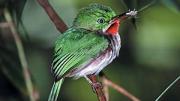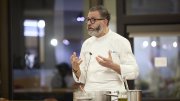At a research station in the Dominican cloud forest, Brian Farrell has just seen, out of the corner of his eye, a prize buzzing by. Ditching his digital camera for a more traditional item from his entomologist's toolbox—a sweep net—he's off, sprinting across the clearing on this ridge at 4,000 feet, swinging hard for a huge beetle in flight.
The insect (above) is a beauty, with a golden pubescence on its wings and serrated, comb-like antennae that tell him it's in the Cerambycidae family. Farrell thinks it might belong to a genus called Mallodon ("bad bite"), and as he explains the meaning of the name the beetle suddenly sinks its jaws into his finger and draws blood—lots of it. Twice more as the beetle is passed around among admiring hands it finds fresh digital targets. The jaws are extremely sharp, able to cut effortlessly through flesh. Farrell, a lifelong naturalist, says matter-of-factly that it's the worst insect bite he has ever sustained.
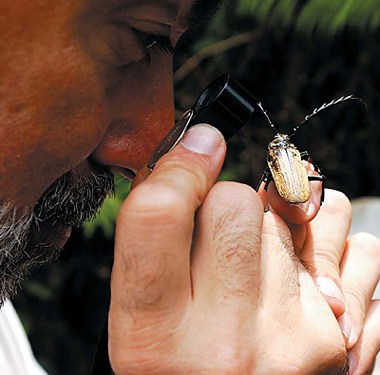 |
Farrell with his assailant, the rare hardwood-feeding beetle Prionus aurepilosus (there were just two specimens among all Dominican collections). |
Photograph by Jonathan Shaw |
The research that has brought Farrell to the cloud forest is part of an effort to document all species of plants and animals on the island of Hispaniola. That work is expected to double the number of known species on the island. Building on that, Farrell, a professor of biology, hopes to tease out how the ecosystem here evolved, to fathom how various insects came to feed on the plants they do, and to learn how those insects provide food for other species higher up the food chain—all in order to understand the complicated web of interdependencies that has evolved here. He hopes that by working on an island, with its discrete boundaries and definable flora and fauna, he can learn things that may eventually help scientists understand other, more complex, living systems worldwide. For a variety of reasons, this particular island is uniquely suited for such study.
Older than the Hawai'ian or Galápagos Islands, Hispaniola rises abruptly from the Caribbean to a mountainous interior. The highest peak tops 10,000 feet. At sea level, the gentle trade winds that stir the leaves of banana and mango trees hold the mercury steady at 82 degrees; but in the highlands the air is much cooler. Frost can touch the ground at night, and farmers grow lettuce and other cool-weather crops. Due partly to the diversity of habitats supported by this unusual range of topography and temperature, and partly to its great age—about 40 million years—the island, which encompasses both Haiti and the Dominican Republic, is one of the richest troves of life on the planet. Coincidentally, it is abundant with the remains of prehistoric insects—mostly ants and beetles—trapped in amber, the fossilized sap of ancient plants. The amber is like a time capsule, says Farrell, that will allow him to extend the reach of his research far into the past.
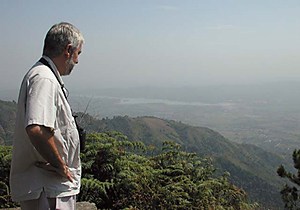 |
The view from the road to Ébano Verde |
Photograph by Jonathan Shaw |
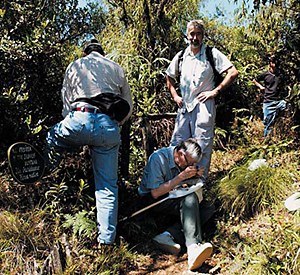 |
Insect-hunting with the former Harvard curator of entomology, E.O. Wilson (seated). Wilson, who is continuing studies of the ants of Hispaniola, teamed with Farrell on a recent island visit to solve the mystery of a sixteenth-century ant plague that forced the relocation of Santo Domingo. |
Photograph by Kelvin Guerrero |
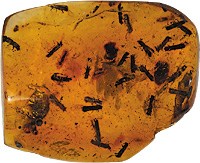 |
Adult ambrosia beetles trapped in fossilized amber |
Photograph by Brian D. Farrell |
The bulk of Farrell's work takes place in a laboratory provided by the director of the Jardín Botánico Nacional, a public garden sanctuary of nearly two square kilometers in the heart of downtown Santo Domingo. Farrell is using high-resolution, computer-aided color photography, coupled with traditional taxonomic description and techniques, to create a bioinformatics database that will be accessible and searchable from anywhere in the world via the Internet. Harvard is a leader in the databasing and imaging of insect collections; the effort to create an on-line, digital catalog of the Museum of Comparative Zoology's primary-type collection of 28,000 insect species serves as a model for the Dominican efforts. The focus initially is on barcoding, photographing, and capturing all the information associated with the plant and insect specimens in the Dominican national collections.
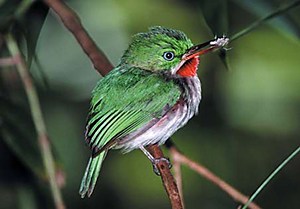 |
The narrow-billed tody, endemic to the highlands of Hispaniola, is a tiny relative of kingfishers that catches an insect or spider, on average, every 30 seconds |
Photograph by Eladio Fernandez |
But today, Farrell is on a collecting expedition in the field, and so has driven up into the mountains of the Cordillera Central. "The high montane habitats are the most endangered and the least explored," he explains. Much of the area, once cloud forest, is now intensively cultivated. Farrell passes a few big rigs climbing the narrow roadway, while smaller, heavily loaded trucks heading the other direction carry sweet potatoes and cucumbers down to coastal markets. He navigates the hazards deftly, narrating all the while the highlights of the passing landscape: to the left, calimetas (Gleichenia bifida and Dicranopteris pectinata), invasive ferns that form dense climax communities but usefully control erosion above the steep roadway cuts; to the right, an endemic magnolia (M. pallescens), ancient in evolutionary terms. The cloud forest begins at about 2,500 feet. (When moisture-laden air blown in from the sea is deflected upward by the mountains, it cools, causing rain, fog, and condensation to form a rainforest-like habitat.) Tree ferns and native begonias dot the landscape. At roughly 3,300 feet, the special montane palms called manacla (Prestoea montana), found nowhere else in the world, start to appear.
Farrell, who combines an easy-going manner with tremendous energy, is an enthusiastic narrator. His early interest in nature blossomed in his grandfather's Vermont apple orchards and the surrounding countryside near Lake Champlain. As an undergraduate at the University of Vermont, he says, "I was able to connect my direct experiences as a boy to the fieldwork requirements of my college classes." He made bird observations, trapped mammals for study, and formed the collections of mosses, plants, and insects required for his various courses in ichthyology, entomology, zoology, ornithology, mammalogy, mycology, lower plants, higher plants, and tropical-plant systematics. That early training has served him well ever since.
Now he stops the car and points to a tree 20 yards away to the right, its crown level with the car windows. "Do you recognize that?" Its leaves are flipping wildly in the gentle air currents stealing up the mountain, exposing a silvery underside. A quaking aspen? No, Farrell explains, it is the native wind tree, palo de viento (Didymopanax tremulus), an example of the parallel evolution that happens "when unrelated species develop similar morphologies as a result of parallel adaptations to their environments." The wind tree is closely related to the umbellifers, he says, the same family as Queen Anne's lace, and is typical of the upper cloud forest.
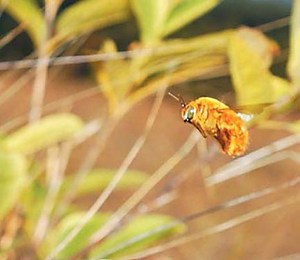 |
Insects of Hispaniola, above and below: The golden carpenter bee, an important pollinator, also mines tree trunks and house beams. |
Photograph by Brian D. Farrell |
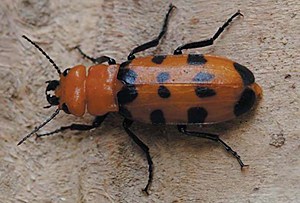 |
The orange meloid beetle, a relative of the infamous Spanish fly, produces a blistering toxin once used in aphrodisiacs. |
Photograph by Brian D. Farrell |
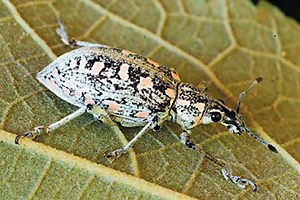 |
Females lay eggs on flowers; the hatchlings hitch rides on golden carpenter bees gathering pollen and then parasitize the bees' larvae in their nests. The weevil genus Exophthalmus may be the island's most diverse. |
Photograph by Brian D. Farrell |
Farrell parks the car at a beautiful scientific reserve called Ébano Verde. A short walk leads down a ridge to an observation tower. Everywhere, bromeliads cling to the trees, catching moisture in cup-like central funnels from the ever-forming condensation on their outstretched leaves. Beyond view, a tody, the endemic kingfisher, calls as huge swifts wheel overhead. At our approach, an anole lizard sunning itself on the tower steps scampers for cover. Farrell plans to bring his students in Biology 156, "Tropical Insect Systematics and Biology," here for spring-break fieldwork.
From the upper deck, looking northwest, we see in the distance a receding series of mountains veiled in mist, as in a Chinese landscape. A steady wind blowing up from the sea plasters clothing to body. Below and to the south, through a thin haze, a low-country lake is visible. From this high vantage point, the beauty of this island's natural habitat is self evident. The idea that half of its biodiversity remains unknown is almost unbelievable. How could so many plants and insects of Hispaniola, in the twenty-first century, remain largely undocumented?
Farrell answers in a word: "Trujillo"—the brutal dictator who ran the Dominican Republic from 1930 to 1961 and who had no time for science.
Farrell knows the story well because his wife's family was instrumental in Trujillo's overthrow. But understanding the present in this way, through the lens of history, extends to his approach to scientific research and distinguishes him from his intellectual predecessors in the field.
In his observations of the ways that groups of related insects interact with plants, Farrell came to realize that "the relationship between any plant and insect can't be understood entirely as a consequence of the immediate environment" because it has "a history that evolved in other environments, in other times, and in other places." To think otherwise, he says, would be "like coming to a place like the Dominican Republic and trying to understand the social life and the particulars of the society today based solely on the present day—how big is the island, what is the productivity—while ignoring the colonial history of the place." (Columbus and his sons, arriving in 1492, enslaved and then wiped out through starvation and disease an estimated 400,000 native Taino Indians in just 27 years. Large numbers also committed suicide in collective ceremonies. The colonizers then imported Africans and Central Americans to replace the extinct tribe, creating a distinctly Latino-African culture that persists to this day.)
As curator of entomology in the Museum of Comparative Zoology (MCZ), Farrell succeeded the legendary sociobiologist E.O. Wilson. Where Wilson observed that animal behaviors are often consistent across great groups of animals, Farrell is less interested in behavior than in resource use. Think of the cartoon showing a series of fish, each about to eat a smaller one and be eaten in turn by a larger one. This Darwinian "trophic pyramid" traces the flow of essential nutrients along the food chain through animals back to plants. The intellectual history of Farrell's approach can be traced back through three generations of students-become-professors to the late G. Evelyn Hutchinson, a biology professor at Yale. Hutchinson was an expert in the ecology of the niche. Farrell, by contrast, studies the evolution of the niche.
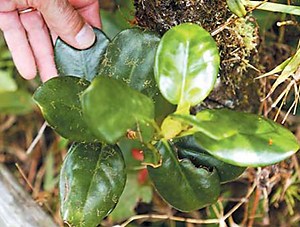 |
Lichens growing on persistent leaves in the presence of constant cloud-forest moisture |
Photograph by Jonathan Shaw |
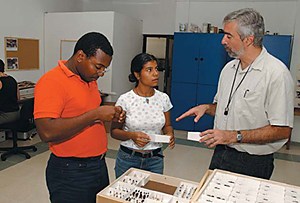 |
Farrell with students Josué Henriquez and Arlen Marmolejo in the Jardín laboratory |
Photograph by Stu Rosner |
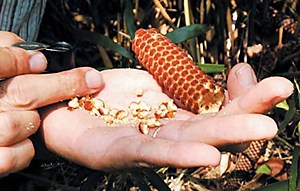 |
A beetle-infested cycad strobilus at the Jardín |
Photograph by Jonathan Shaw |
Farrell almost became a botanist instead of an entomologist, but found a way to combine the two interests by studying coevolution. In the early 1980s, there was a theory that insects and plants had coevolved. But absent evidence, many in the scientific community were growing skeptical of the idea. While working as a graduate student with the beetle collections of the Smithsonian Institution in 1982, Farrell discovered that "underneath many of the beetle specimens, there were these old scribbled labels" noting the host plant on which they had been found. He identified five species of a single genus that all fed on a bitter and toxic shrub called Scutellaria. In the field, he discovered four or five more species also feeding on the same genus of host plant, and set out to reconstruct the phylogeny, or family tree, of the beetle. Scouring the literature, he was also able to find a sketch of the plant's evolutionary history, worked out by an early botanist. "The prediction was that there would be some strong correspondence [in the family-tree histories] if the plant and the beetles had evolved side by side," says Farrell. "The beetles would reflect the sequence of branching events in the plants." He soon found that in each case, the most primitive forms were associated with each other, and devised a statistical test to show that the correspondences were greater than expected by chance. This was the first evidence for a system of insects and plants that had coevolved.
Farrell then thought he should be able to predict—for a beetle whose feeding habits were unknown—what species of the host plant it would be feeding on, based solely on phylogenetic histories. He made a prediction based on a museum beetle specimen, and then traveled to the scrubland of the Lake Wales ridge in Central Florida where the insect had originally been collected. He found the beetle feeding on precisely the host plant he had expected. The find was a remarkable validation of the theory and his methods.
While working on the Scutellaria feeders, Farrell began to see a pattern. "I noticed in the fossil record," he says, "that some of those beetles feeding on the older plants also had old fossil histories. The relationships suggested to me that if I could reconstruct the evolutionary history of all those different lineages" using modern molecular techniques, this might reveal "a more dramatic imprint of evolutionary history on today's communities than had otherwise been appreciated."
Farrell went on to pinpoint the origins of plant feeding in insects, and showed that herbivory in general drives insect diversity. He demonstrated that it is the species diversity of plants that drives insect diversity, rather than merely the abundance of plant material. Beetles have capitalized on this best, and are more diverse than any other animal or plant group, a fact famously memorialized by the evolutionary biologist J.B.S. Haldane. When asked by a group of clergy what a lifetime of studying the Creation had revealed about the mind of the Creator, he is said to have replied, "An inordinate fondness for beetles."
Farrell published his exegesis of Haldane's dilemma—"'Inordinate Fondness' Explained: Why are there so many beetles?"—in Science in 1998. He showed that the number of species exploded whenever a beetle made the jump to feeding on angiosperms (flowering plants, which come in many species), from feeding on gymnosperms (conifers, cycads, ginkgoes, and the like, with their more limited numbers of species).
But he also showed that these insect communities are profoundly old and had been feeding on plants long before the angiosperm explosion, the period when flowering plants suddenly appeared. Over time, as gymnosperm species diversity worldwide dwindled due to the adaptive advantages of angiosperms, the vast majority of beetle groups did not make the switch to flowering plants. "There is a profound implication here," says Farrell. "The age of these insect groups suggests that there surely must have been opportunities for better host plants available over time. But," he says, "they stayed on the same host even as it dwindled in abundance, which implies to me that there are genetic limits to the abilities of species to shift among resources." "If those plants go extinct," says Farrell, "so will those beetles."
On the other side, every time a beetle group did make the shift over to angiosperm feeding, "diversity went up between a hundred- and a thousandfold, contributing several hundred thousand new species to the planet." Angiosperm feeders now make up half of all beetle groups. All of the major herbivorous groups of insects (bees, ants, wasps, butterflies, moths) follow a similar pattern. They first made the shift from carnivory by feeding on primitive plant groups, says Farrell, "mostly on the cones of either cycads or conifers," which are the most protein-rich parts of plants, and therefore, from a nutritional standpoint, most like the insect bodies from which these former carnivores weaned themselves over the course of evolutionary time. Then a few groups shifted even further onto angiosperms and speciated rapidly.
Back in Santo Domingo next morning, Farrell heads for the Jardín Botánico Nacional. One of the biggest arboreta in the world, it is an oasis of biodiversity in the middle of a city of two million people. Between the road and a slow-flowing arroyo, philodendrons thrive in the shade of royal palms, almendra (the native West Indian almond), and Castilla elástica (a source of latex). The garden also hosts a large collection of cycads, Jurassic-looking, sexed plants with an ancient association with weevils. The garden's director, Milcíades Mejía, has given Farrell permission to harvest plant parts in his search for insects, so Farrell stops to check one of the male plants for beetles. Adult beetles mate on the males' cone-shaped strobili, and then the females lay their eggs inside, where the larvae hatch and feed. Farrell breaks open a strobilus and finds it swarming with beetles. These beetles can also be found on cycads in Africa and in Australia, he says, suggesting that this is an ancient distribution.
The Jardín is also home to mud daubers, 30 species of katydids, and a nocturnal arachnid that preys on crickets; limpkins, black-whiskered vireos, gallinules, coots, least grebes, and spotted sandpipers (northern migrants); all manner of butterflies, including brilliant blue nymphalids; sliders (endemic turtles); enormous termite nests attached to the sides of trees like giant galls; and great sphinx moth caterpillars that denude the Plumeria trees. Says Farrell, "one could have any number of research projects right here in the garden."
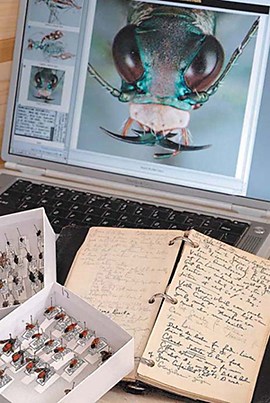 |
Using the 1938 journals of the late Harvard curator of entomology P. J. Darlington, Farrell has collected beetles from many of the same sites. |
Photograph by Stu Rosner |
The bioinformatics project is housed in the midst of the Jardín in a low building with a capacious interior where students of the oldest university in the Western hemisphere—the Universidad Autónoma de Santo Domingo, founded in 1538—are hard at work photographing and cataloging specimens from the Dominican national collections. It is an empowering project, says Farrell, not only because they are gathering information about every species in one place (there are no field guides for insects anywhere in the Caribbean), but because the process is building the capacity of local institutions to use new digital technology and practice modern collecting techniques.
The students greet Farrell with a problem: they have found live beetles in the dry-mounted plant specimens. A glance tells Farrell all he needs to know: these beetles eat collections. They probably entered through open windows when, for a couple of weeks, there was no power to run the air conditioning. The plant specimens will need to be frozen to stop the infestation.
In the laboratory, Farrell's MCZ assistants Sarah Ashworth and Jen Fogarty teach local students how to get the best results from a digital camera mounted on a high-power microscope. Because a camera's depth of field is very shallow at high magnifications, the project uses software to stitch together a series of images, focused on just a narrow sliver of an insect. The resolution of the resulting composite is so high that operators of the equipment have occasionally seen tiny crystals of naphthalene (a preservative) on the hairs of a beetle's back.
Each week, trays of pinned and mounted insects arrive from the national museum. Farrell and another scientist identify them to the lowest taxonomic level possible. Sometimes this is tricky: the insects may be from taxa that no longer exist, or they may be like the endemic Calisto butterfly, which is speciating very rapidly. Calistos are extremely weak fliers—which isolates them from other Calisto populations. This so-called "island effect," which leads to species proliferation, can also be caused either by isolation and lack of competition on actual islands (like Hispaniola) or on "effective islands," like the exclusive relationship of an herbivorous insect with a toxic host plant such as Scutellaria. Other Hispaniolan species, like the giant sphinx moth, can fly great distances, so the Dominican species are largely the same as those in Argentina.
The visit to the Jardín is punctuated with a lunch of local foods—fried plantains, con-con (the crispy burned rice from the bottom of the pot, a delicacy), mahi mahi, and African pigeon peas cooked in garlic, green onions, cilantro, and tomato paste: the view is good from the top of the trophic pyramid. A meal that yesterday would have been eaten with great appreciation but little reflection is, after two days with Farrell, rich with the lessons of natural history.
The plátanos, for example, have been implicated in a plague of fire ants so severe that it forced the city of Santo Domingo to relocate from one side of the river to the other. Writing in 1520, Brother Bartolomé de Las Casas warned, "You cannot escape them, unless you put the feet of your bed in buckets of water." Plantains carry a scale insect tended by fire ants, Farrell explained. When the Spanish brought plantains to Hispaniola in 1516, this introduced a huge resource of sugar-producing scales, causing ant populations to skyrocket.
The African pigeon peas we're eating are another story. Beetles like them, too. "Most beans—red, white, and black—are New World in origin," explains Farrell. Old World beetles (as introduced pests in the New World) don't drill New World beans. "They haven't figured that out yet. But these African gandules are Old World."
Beetles have been eating human harvests for a very long time—they're found in the Egyptian pyramids and "they're huge impact insects," Farrell says. "They take about one-quarter to a third of the grain crop every year." In fact, the U.S. Department of Agriculture has invested in super-sensitive listening devices for silos in order to listen for weevils chewing.
Monocots like palms, orchids, bamboo, grasses, rice, corn, and wheat "are where most of the action is," says Farrell. "During World War I, Australia kept stores of grain that were destined to be shipped into Europe for the war effort. But the docks were so infested that the workers had to stop by about 1 o'clock in the afternoon. The air was so thick with flying beetles that they couldn't breathe. From just one dock, each day they swept up about a ton of weevils, which is about a billion of them." In fact, there are more weevils than any other species on earth, he says: about 4 quadrillion at any one time.
How do these beetles fit into the trophic pyramid? The grains they eat exclusively lack essential amino acids. So the beetles make their own. At some point in their evolutionary history, they captured amino acid-producing endosymbiotic bacteria that today appear nowhere else in nature. The bacteria produce the nutrients the beetles need. "Our French colleagues are working on the physiology and phylogeny of these bacteria," Farrell says, "while we work on the weevils."
What does Farrell ultimately hope to learn from his research program? By studying ancient plants and the fauna that are associated with them, he can ask comparative questions about the age, origin, and subsequent evolution of the various members of a plant group's fauna. "And similarly," he says, "the way you study host plants as islands you can study actual islands, asking some of the same questions about them, such as when did a particular lineage arrive, and what were the consequences of the timing of that arrival? Are the first inhabitants of a plant or an island the first to fill all the available niches, leaving the later ones just what is left over? Are the original inhabitants still around and are they more diverse or are they different in any way?"
From the insect perspective, his research examines how a particular species colonizes different plant groups in succession, or comes to colonize the different islands or continents it occupies. These kinds of questions are more easily answered on Hispaniola than they might be elsewhere because of the abundant amber deposits, 30 million to 40 million years old. Insects that successfully broke the skin of a particular leguminous tree became trapped in its resinous secretions, thus providing a rich record of colonization and speciation events in the island's history.
"In documenting the flora and fauna here," says Farrell, "we are not just providing a community service; we are helping to integrate the information that is available—the kind of information I draw on every day for my research—and helping to point the way to places where more research needs to be done." The effort will serve as a model for ongoing work to inventory all species of life on Earth within the next 25 years. "I hope that what I can learn about the evolution of the biota on Hispaniola," says Farrell, "is representative of evolution on the planet at large."
Jonathan Shaw '89 is managing editor of this magazine.
